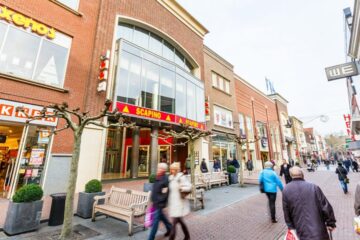Amsterdam, 12 November 2024
It has been a turbulent decade for physical retail. Back in 2015, annual European retail investment topped a record €70 billion, in December of that year the Office for National Statistics revealed that retail sales in Great Britain had risen for 32 consecutive months, and prime retail rents were increasing across the likes of Germany and France.
In the intervening period, European retail investment nearly halved, rental rates declined 14,3% from the peak in Q3 2018 to Q4 2023, while prime yields for Shopping Centers have expanded from 4,2% to 6,2%, and as recently as 2021 the retail share of total investment activity in Europe dropped to just 10%.
As is always the case after a period of significant change, many have tried to call the bottom and identify the turning point from which the retail sector will begin to recover, and there have been more than a few false dawns.
However, there are now enough data points to suggest that we can look to the future with at least cautious optimism.
Looking at the macro headlines first of all, the unemployment rate in Europe has fallen to 6,4% from over 7,5% in 2020. Eurozone GDP expanded by 0,9% in the third quarter year-on-year, and inflation in the UK and Europe has fallen significantly. On top of that, the European Central Bank has cut its key deposit rate to 3.25% from a high of 4%, while the Bank of England has also started to reduce its Bank Rate.
Alongside that, operationally prime retail assets such as shopping centres in dominant locations are performing more strongly. Footfall across Multi’s portfolio of larger shopping centres in continental Europe is back on par with 2019 levels, while sales have increased significantly compared to 2019. Importantly, collection rates have recovered and occupancy is at 95% on average with some properties experiencing waiting lists for tenants looking to open or enlarge a store.
Of course, any conversation about the retail sector has to include online, but the story for retail property is looking rosier here as well. While during Covid all the talk was of a permanent shift in shopping habits, in truth the data shows that the pandemic only brought forward growth, with the e-commerce penetration rate falling in many geographies in the years post-covid before flattening.
However, it is important to remember that not all retail is equal. Besides the asset type, the age of a building and level of historical capital expenditure, the layout, tenancy mix, and accessibility are all crucial components when it comes to its overall performance, as is, importantly, its position within the local catchment area.
On top of that, active asset management is critical. A great example of this is the London Designer Outlet, which was developed by Quintain and managed by Multi-Realm since it opened in 2013. Building anything new clearly brings a honeymoon period but we no longer live in the era of “build it and they will come”; creating a sense of place, belonging, novelty, all fuelled by data, are now the stock in trade of the proactive asset manager.
Since the end of the pandemic, a proactive strategy and data-led management have been crucial to adding value. Out of the 18 months to September, 14 saw record-breaking trading at the centre, and the LDO also had its best ever summer earlier this year. On top of that, in the 12 months to September, four brands were added to its line-up, and three stores underwent major upgrades.
Another great example is Multi’s Forum Palermo, Sicily, the largest shopping centre in the city, which the company developed and has managed since it opened in 2009. Multi completed an extension and renovation of its food court area in 2021, with the objective of expanding and improving the range and quality of dining options at the mall to increase both footfall and dwell time. As part of this, five new restaurants and three new kiosks were added, and a new terrace area was created along with a much larger indoor seating area. The new space covers 1.400 sqm and increased the share of F&B rental income to 7,2%. Upon completion, food court sales increased by more than a quarter compared with the same period in 2019, and the overarching shopping experience has been much improved.
All in all, given what has happened over the last ten years making predictions is clearly a fool’s game, but it is fair to say that based on the data, latest trends, and sentiment from those within the sector, the outlook for retail property is looking a lot more favourable. That being said, the gap in performance between under-invested, non-dominant assets and those that are managed proactively will only widen as consumers become increasingly discerning with their time and money. If you’re the owner of retail property, there’s no time like the present to review the business plan to ensure it’s well positioned for the future.
Elmar Schoonbrood, Co-CEO Multi Corporation


